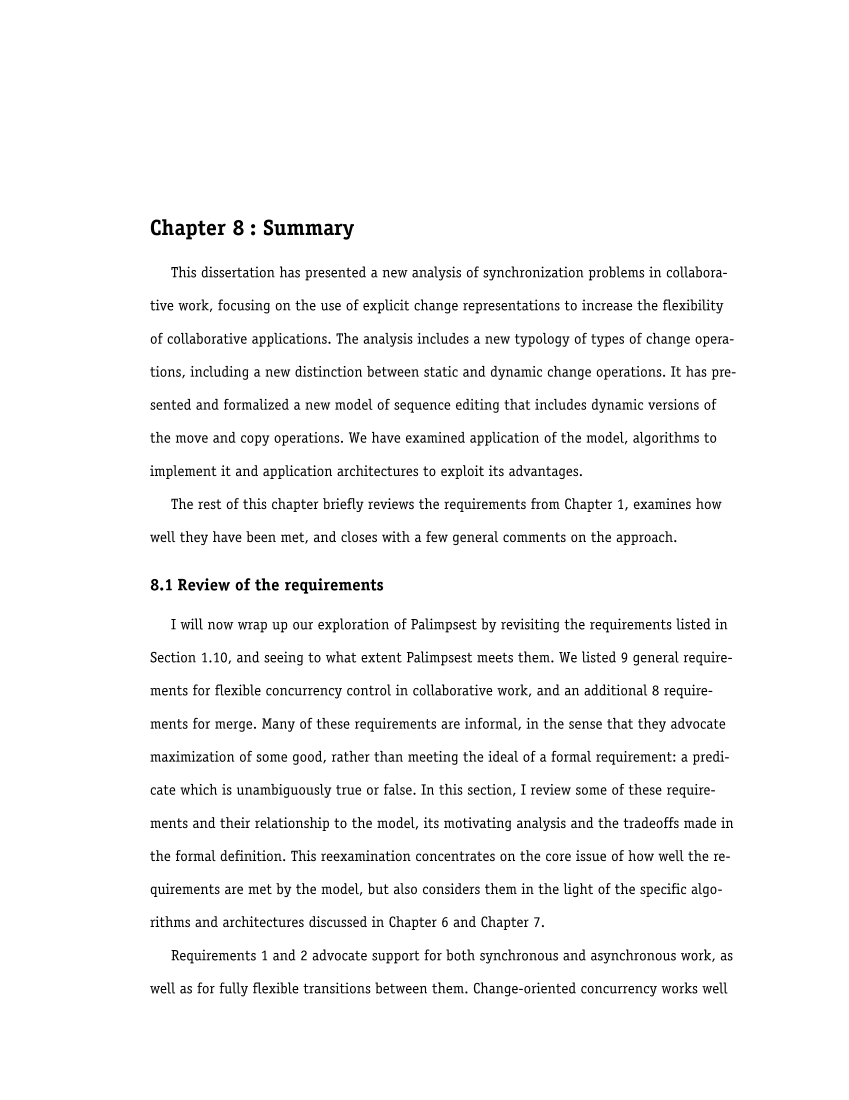Chapter�8 : Summary
This�dissertation�has�presented�a�new�analysis�of�synchronization�problems�in�collabora-
tive�work,�focusing�on�the�use�of�explicit�change�representations�to�increase�the�flexibility
of�collaborative�applications.�The�analysis�includes�a�new�typology�of�types�of�change�opera-
tions,�including�a�new�distinction�between�static�and�dynamic�change�operations.�It�has�pre-
sented�and�formalized�a�new�model�of�sequence�editing�that�includes�dynamic�versions�of
the�move�and�copy�operations.�We�have�examined�application�of�the�model,�algorithms�to
implement�it�and�application�architectures�to�exploit�its�advantages.
The�rest�of�this�chapter�briefly�reviews�the�requirements�from�Chapter�1,�examines�how
well�they�have�been�met,�and�closes�with�a�few�general�comments�on�the�approach.
8.1 Review�of�the�requirements
I�will�now�wrap�up�our�exploration�of�Palimpsest�by�revisiting�the�requirements�listed�in
Section�1.10,�and�seeing�to�what�extent�Palimpsest�meets�them.�We�listed�9�general�require-
ments�for�flexible�concurrency�control�in�collaborative�work,�and�an�additional�8�require-
ments�for�merge.�Many�of�these�requirements�are�informal,�in�the�sense�that�they�advocate
maximization�of�some�good,�rather�than�meeting�the�ideal�of�a�formal�requirement:�a�predi-
cate�which�is�unambiguously�true�or�false.�In�this�section,�I�review�some�of�these�require-
ments�and�their�relationship�to�the�model,�its�motivating�analysis�and�the�tradeoffs�made�in
the�formal�definition.�This�reexamination�concentrates�on�the�core�issue�of�how�well�the�re-
quirements�are�met�by�the�model,�but�also�considers�them�in�the�light�of�the�specific�algo-
rithms�and�architectures�discussed�in�Chapter�6�and�Chapter�7.
Requirements�1�and�2�advocate�support�for�both�synchronous�and�asynchronous�work,�as
well�as�for�fully�flexible�transitions�between�them.�Change-oriented�concurrency�works�well
This�dissertation�has�presented�a�new�analysis�of�synchronization�problems�in�collabora-
tive�work,�focusing�on�the�use�of�explicit�change�representations�to�increase�the�flexibility
of�collaborative�applications.�The�analysis�includes�a�new�typology�of�types�of�change�opera-
tions,�including�a�new�distinction�between�static�and�dynamic�change�operations.�It�has�pre-
sented�and�formalized�a�new�model�of�sequence�editing�that�includes�dynamic�versions�of
the�move�and�copy�operations.�We�have�examined�application�of�the�model,�algorithms�to
implement�it�and�application�architectures�to�exploit�its�advantages.
The�rest�of�this�chapter�briefly�reviews�the�requirements�from�Chapter�1,�examines�how
well�they�have�been�met,�and�closes�with�a�few�general�comments�on�the�approach.
8.1 Review�of�the�requirements
I�will�now�wrap�up�our�exploration�of�Palimpsest�by�revisiting�the�requirements�listed�in
Section�1.10,�and�seeing�to�what�extent�Palimpsest�meets�them.�We�listed�9�general�require-
ments�for�flexible�concurrency�control�in�collaborative�work,�and�an�additional�8�require-
ments�for�merge.�Many�of�these�requirements�are�informal,�in�the�sense�that�they�advocate
maximization�of�some�good,�rather�than�meeting�the�ideal�of�a�formal�requirement:�a�predi-
cate�which�is�unambiguously�true�or�false.�In�this�section,�I�review�some�of�these�require-
ments�and�their�relationship�to�the�model,�its�motivating�analysis�and�the�tradeoffs�made�in
the�formal�definition.�This�reexamination�concentrates�on�the�core�issue�of�how�well�the�re-
quirements�are�met�by�the�model,�but�also�considers�them�in�the�light�of�the�specific�algo-
rithms�and�architectures�discussed�in�Chapter�6�and�Chapter�7.
Requirements�1�and�2�advocate�support�for�both�synchronous�and�asynchronous�work,�as
well�as�for�fully�flexible�transitions�between�them.�Change-oriented�concurrency�works�well





























































































































































































